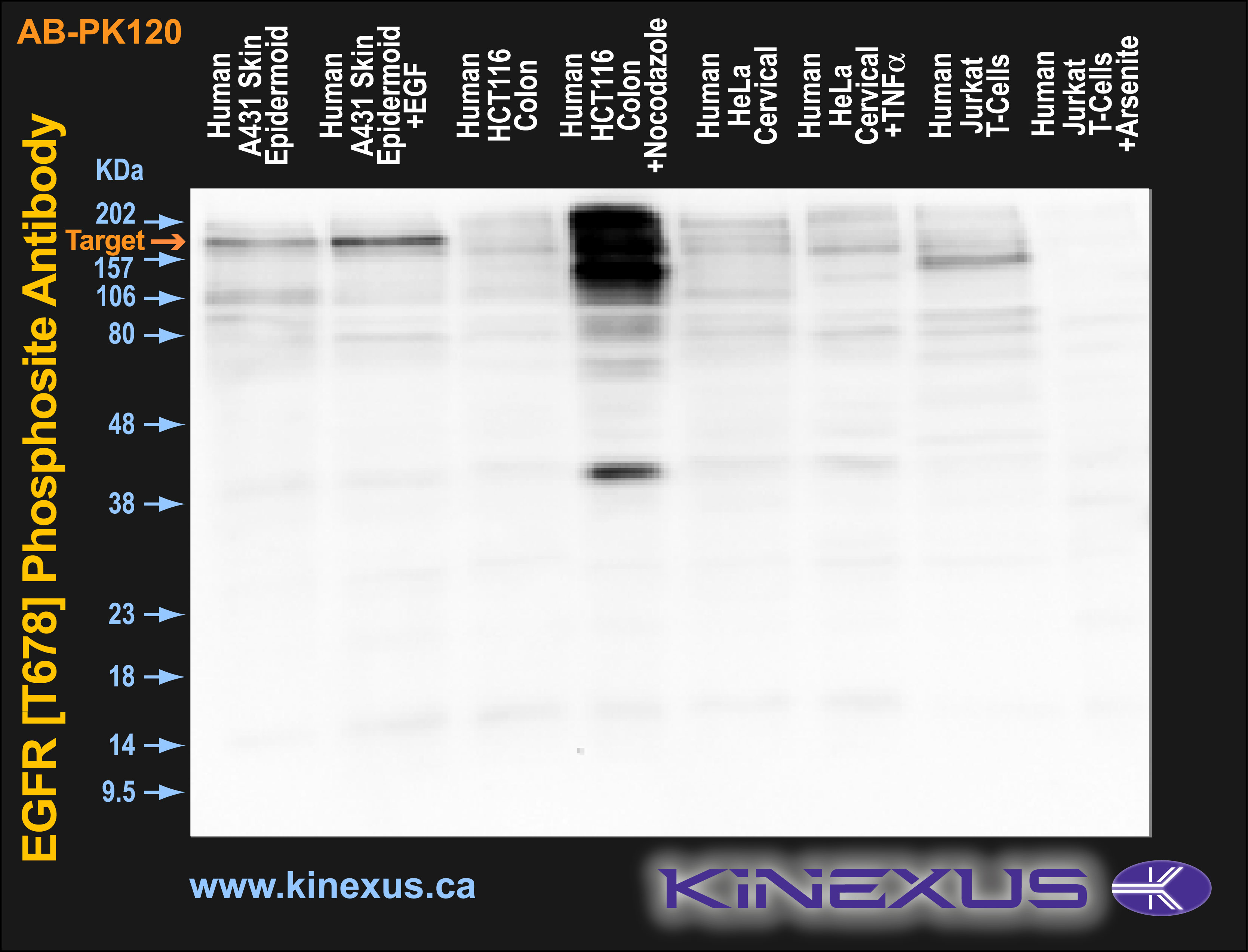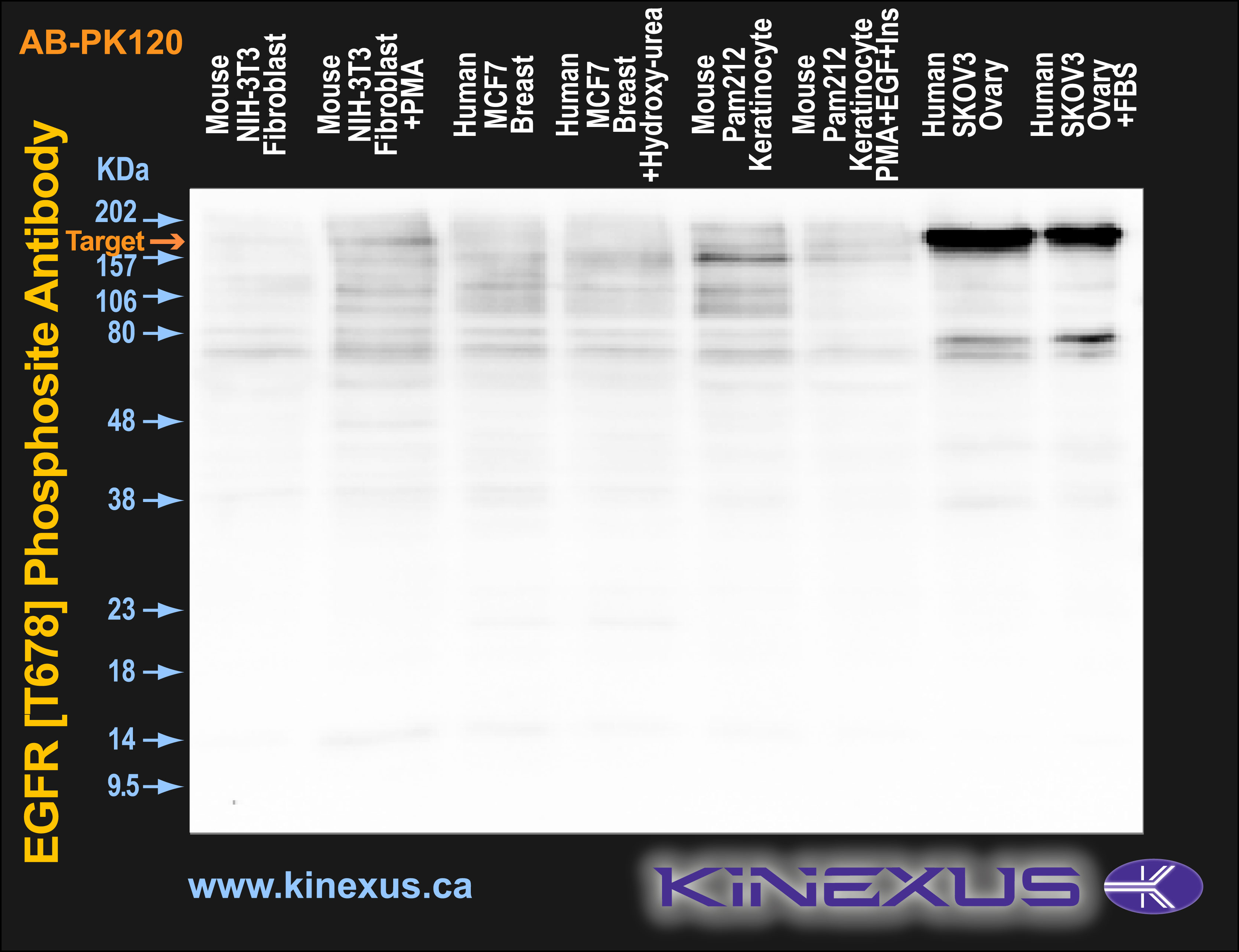Product Name: EGFR-pT678
Product Number: AB-PK120
| Size: | 25 µg | Price: | 89.00 | |
| $US |
Target Full Name: Receptor protein-tyrosine kinase epidermal growth factor receptor Thr-678 phosphosite
Target Alias: Avian erythroblastic leukemia viral (v-erb-b) oncogene homologue; Cell growth inhibiting protein 40; cell proliferation-inducing protein 61; ERBB; ERBB1; HER1; mENA; PIG61; Proto-oncogene c-ErbB-1; Receptor tyrosine-protein kinase erbB-1
Product Type Specific: Phosphosite-specific polyclonal antibody for human EGFR T678 phosphosite
Antibody Code: PK120
Antibody Target Type: Phosphosite-specific
Antibody Phosphosite: T678
Protein UniProt: P00533
Protein SigNET: P00533
Target Alias: Avian erythroblastic leukemia viral (v-erb-b) oncogene homologue; Cell growth inhibiting protein 40; cell proliferation-inducing protein 61; ERBB; ERBB1; HER1; mENA; PIG61; Proto-oncogene c-ErbB-1; Receptor tyrosine-protein kinase erbB-1
Product Type Specific: Phosphosite-specific polyclonal antibody for human EGFR T678 phosphosite
Antibody Code: PK120
Antibody Target Type: Phosphosite-specific
Antibody Phosphosite: T678
Protein UniProt: P00533
Protein SigNET: P00533
Antibody Type: Polyclonal
Antibody Host Species: Rabbit
Antibody Ig Isotype Clone: IgG
Antibody Immunogen Source: Peptide with amino acid sequence surrounding the human EGFR Thr-678 phospho-site (Lys-Arg-pThr-Leu-Arg)
Antibody Immunogen Sequence: KRpTLR
Antibody Immunogen Description: 5 amino acid phosphopeptide corresponding to the human EGFR T678 phosphosite
Production Method: The antibody was affinity-purified from rabbit antiserum by affinity-chromatography using epitope-specific phosphopeptide. The antibody against non-phosphopeptide was removed by chromatography using non-phosphopeptide corresponding to the phosphorylation site.
Antibody Concentration: 1 mg/ml
Antibody Host Species: Rabbit
Antibody Ig Isotype Clone: IgG
Antibody Immunogen Source: Peptide with amino acid sequence surrounding the human EGFR Thr-678 phospho-site (Lys-Arg-pThr-Leu-Arg)
Antibody Immunogen Sequence: KRpTLR
Antibody Immunogen Description: 5 amino acid phosphopeptide corresponding to the human EGFR T678 phosphosite
Production Method: The antibody was affinity-purified from rabbit antiserum by affinity-chromatography using epitope-specific phosphopeptide. The antibody against non-phosphopeptide was removed by chromatography using non-phosphopeptide corresponding to the phosphorylation site.
Antibody Concentration: 1 mg/ml
Storage Buffer: Phosphate buffered saline (without Mg2+ and Ca2+), pH 7.4, 150 mM NaCl, 0.02% sodium azide and 50% glycerol
Storage Conditions: -20°C
Storage Stability: > 1 year
Product Use: Western blotting
Antibody Dilution Recommended: 2 µg/mL
Antibody Potency: Very strong
Antibody Species Reactivity: Human, Mouse, Rat
Antibody Positive Control: T678 phosphorylated EGFR
Antibody Specificity: Very high
Antibody Cross Reactivity: No strong cross-reactivities with other proteins.
Storage Conditions: -20°C
Storage Stability: > 1 year
Product Use: Western blotting
Antibody Dilution Recommended: 2 µg/mL
Antibody Potency: Very strong
Antibody Species Reactivity: Human, Mouse, Rat
Antibody Positive Control: T678 phosphorylated EGFR
Antibody Specificity: Very high
Antibody Cross Reactivity: No strong cross-reactivities with other proteins.
Related Product 1: EGFR-1 pan-specific antibody (Cat. No.: AB-NK052-5)
Related Product 2: EGFR-2 pan-specific antibody (Cat. No.: AB-NK052-6)
Related Product 3: EGFR-3 pan-specific antibody (Cat. No.: AB-NK052-4)
Related Product 4: EGFR-4 pan-specific antibody (Cat. No.: AB-NK052-7)
Related Product 5: EGFR-5 pan-specific antibody (Cat. No.: AB-NK052-8)
Related Product 6: EGFR-pY1069 phosphosite-specific antibody (Cat. No.: AB-PK599)
Related Product 7: EGFR-pY1110 phosphosite-specific antibody (Cat. No.: AB-PK600)
Related Product 8: EGFR-pY1172 phosphosite-specific antibody (Cat. No.: AB-PK601)
Related Product 2: EGFR-2 pan-specific antibody (Cat. No.: AB-NK052-6)
Related Product 3: EGFR-3 pan-specific antibody (Cat. No.: AB-NK052-4)
Related Product 4: EGFR-4 pan-specific antibody (Cat. No.: AB-NK052-7)
Related Product 5: EGFR-5 pan-specific antibody (Cat. No.: AB-NK052-8)
Related Product 6: EGFR-pY1069 phosphosite-specific antibody (Cat. No.: AB-PK599)
Related Product 7: EGFR-pY1110 phosphosite-specific antibody (Cat. No.: AB-PK600)
Related Product 8: EGFR-pY1172 phosphosite-specific antibody (Cat. No.: AB-PK601)
Scientific Background: EGFR is a receptor-tyrosine kinase for epidermal growth factor (EGF) and related growth factors including Transforming growth factor (TGF)-alpha, amphiregulin, betacellulin, heparin-binding EGF-like growth factor, GP30, and vaccinia virus growth factor. EGFR is involved in the control of cell growth and differentiation. Ligand binding to this receptor results in receptor dimerization, autophosphorylation (in trans), activation of various downstream signaling molecules and lysosomal degradation. It can be phosphorylated and activated by Src. Activated EGFR binds to the SH2 domain of phospholipase C-gamma (PLC-gamma) and activates downstream signaling from this phospholipase. Grb2 and SHC bind to phospho-EGFR and are involved in the activation of MAP kinase signaling pathways. Phosphorylation on Ser and Thr residues appears to attenuate of EGFR kinase activity. Phosphorylated EGFR binds Cbl, leading to its ubiquitination and degradation. Four alternatively spliced isoforms have been described with molecular masses of 134,277, 77,312, 69,288 and 44,664 Da. EGFR is unbiquitously expressed in normal tissues, and overexpressed in breast, head and neck cancers, which correlated with poor survival. Activating somatic mutations are seen in lung cancer, which in a minority of patients with strong responses to the EGFR inhibitor Iressa (Gefitinib, ZD1839). Other inhibitors include Erbitux, Tarceva, and Lapatinib.
Figure 1. Immunoblotting of various cell lines with AB-PK120 antibody at a 500 X dilution. The target protein EGFR is indicated. Each lane was loaded with 15 µg of cell lysate protein. The max signal count was 43466.
Figure 2. Immunoblotting of various cell lines with AB-PK120 antibody at a 500 X dilution. The target protein EGFR is indicated. Each lane was loaded with 15 µg of cell lysate protein. The max signal count was 52658.
References
[1] Gamou S, Shimizu N. Hydrogen peroxide preferentially enhances the tyrosine phosphorylation of epidermal growth factor receptor. FEBS Lett. 1995 Jan 3;357(2):161-4. PMID: 7805884
[2] Doherty JK, Bond C, Jardim A, Adelman JP, Clinton GM. The HER-2/neu receptor tyrosine kinase gene encodes a secreted autoinhibitor. Proc Natl Acad Sci U S A. 1999 Sep 14;96(19):10869-74. PMID: 10485918.
[3] Tyrosine phosphorylation of selected secretory carrier membrane proteins, SCAMP1 and SCAMP3, and association with the EGF receptor. Wu TT, Castle JD. Mol Biol Cell. 1998 Jul;9(7):1661-74. PMID: 9658162.
[1] Gamou S, Shimizu N. Hydrogen peroxide preferentially enhances the tyrosine phosphorylation of epidermal growth factor receptor. FEBS Lett. 1995 Jan 3;357(2):161-4. PMID: 7805884
[2] Doherty JK, Bond C, Jardim A, Adelman JP, Clinton GM. The HER-2/neu receptor tyrosine kinase gene encodes a secreted autoinhibitor. Proc Natl Acad Sci U S A. 1999 Sep 14;96(19):10869-74. PMID: 10485918.
[3] Tyrosine phosphorylation of selected secretory carrier membrane proteins, SCAMP1 and SCAMP3, and association with the EGF receptor. Wu TT, Castle JD. Mol Biol Cell. 1998 Jul;9(7):1661-74. PMID: 9658162.
[4] O'Rourke DM, Qian X, Zhang HT, Davis JG, Nute E, Meinkoth J, Greene MI. Trans receptor inhibition of human glioblastoma cells by erbB family ectodomains. Proc Natl Acad Sci U S A. 1997 Apr 1;94(7):3250-5. PMID: 9096379.
[5] Noguchi T, Matozaki T, Horita K, Fujioka Y, Kasuga M. Role of SH-PTP2, a protein-tyrosine phosphatase with Src homology 2 domains, in insulin-stimulated Ras activation. Mol Cell Biol. 1994 Oct;14(10):6674-82. PMID: 7935386.
[6] Kanner SB, Reynolds AB, Parsons JT. Tyrosine phosphorylation of a 120-kilodalton pp60src substrate upon epidermal growth factor and platelet-derived growth factor receptor stimulation and in polyomavirus middle-T-antigen-transformed cells. Mol Cell Biol. 1991 Feb;11(2):713-20. PMID: 1703631.
[5] Noguchi T, Matozaki T, Horita K, Fujioka Y, Kasuga M. Role of SH-PTP2, a protein-tyrosine phosphatase with Src homology 2 domains, in insulin-stimulated Ras activation. Mol Cell Biol. 1994 Oct;14(10):6674-82. PMID: 7935386.
[6] Kanner SB, Reynolds AB, Parsons JT. Tyrosine phosphorylation of a 120-kilodalton pp60src substrate upon epidermal growth factor and platelet-derived growth factor receptor stimulation and in polyomavirus middle-T-antigen-transformed cells. Mol Cell Biol. 1991 Feb;11(2):713-20. PMID: 1703631.
© Kinexus Bioinformatics Corporation 2017



